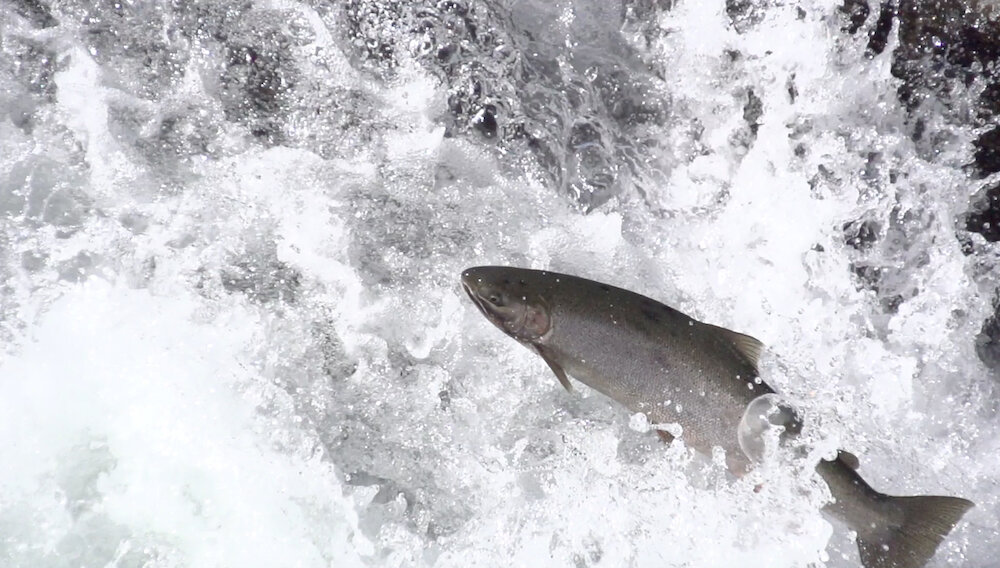
Migratory Rainbows
Steelhead are the anadromous form of rainbow trout (Oncorhynchus mykiss), meaning they are born in freshwater river systems and migrate to the Pacific Ocean where they spend years growing before returning as adults to their natal rivers to spawn. In fact, steelhead and rainbow trout are genetically identical. The only difference is that steelhead are anadromous while rainbow trout spend their entire lives in freshwater.
Wild steelhead are native to the watersheds of the northern Pacific Rim, and their historic range extended from the Kamchatka Peninsula in Russia to the border between California and Mexico. This range included watersheds in Alaska and the Aleutian Islands, British Columbia and Vancouver Island, and along the entire West Coast of the United States. Some populations of these remarkable fish migrate as far inland as Idaho, swimming hundreds of miles and climbing thousands of feet of elevation in the process.
Unlike their cousins the Pacific salmon, which die at the end of their spawning runs, steelhead are capable of repeating these migratory journeys multiple times throughout their lives. However, only a small percentage of steelhead manage to complete multiple spawning migrations because of the high mortality rate experienced during these arduous journeys between fresh and salt water environments.
“Wherever wild steelhead are found, they are revered by anglers for their power, resilience, and grace.”
Summer and Winter Fish
Throughout their native range, steelhead can be found migrating to their home waters during every month of the year. Typically, steelhead are categorized as either summer-run or winter-run depending upon the time of year they return to freshwater.
Summer steelhead enter the rivers as sexually immature fish, often migrate the farthest distances, and wait as many as ten months in freshwater prior to spawning. Winter steelhead are predominately found in coastal watersheds, arrive anytime from November to May as sexually mature fish, and spawn shortly after their return to natal waters. Depending on a river’s location and structure, watersheds can support a combination of both winter and summer steelhead or exclusively either summer or winter fish.
Beyond the distinction between summer and winter migrations, steelhead display an astounding variety of life histories within a given river system or population. This diversity is a key element of the species’ resilience as it makes them more equipped to adapt to changing conditions in volatile ecosystems, a trait which is becoming increasingly important due to climate change.
These divergent life histories emerge early in a steelhead life. In many cases, juvenile steelhead, even those rising out of the same redd with the same parents, will stay in freshwater different amounts of time before becoming smolts and migrating out to the Pacific. Once there, steelhead are solitary creatures and will remain at sea for varying amounts of time, sometimes years longer than others, before returning to spawn.
In other cases, steelhead offspring will opt to remain permanently in freshwater, living out their lives as resident rainbow trout. This life history is a powerful adaptation strategy because research has shown that resident rainbow trout are capable of successfully spawning with steelhead and producing offspring that will eventually migrate to the ocean. In years of low returns, these resident rainbow trout play an important role maintaining steelhead populations.
Generations of Decline
Tragically, a destructive combination of human activities - overharvest, habitat loss, dams, pollution, and genetic degradation caused by hatchery fish - have coalesced over the last century to dramatically reduce wild steelhead populations throughout their native range. In fact, of the fifteen distinct wild steelhead populations in the Lower 48, twelve are listed as endangered, threatened, or areas of concern.
For example, Puget Sound, which in 1900 boasted an annual return of one million wild steelhead, now experiences a run of around 14,000 fish, a 97-99 percent decline in the last 120 years. While this decline is staggering and gut wrenching, it is by no means abnormal as once mighty steelhead runs throughout the wild steelhead’s range now stand on the brink of extirpation.
However, not all is doom and gloom as there are stories of success and examples of wild steelhead populations rebounding and showing signs of improvement where wise management practices are in place and wild fish recovery is prioritized. These signs of success are what fuel the Wild Steelhead Coalition to work tirelessly on behalf of wild steelhead throughout the region and why we advocate for scientifically robust management practices.
Wild steelhead have shown time and again that when they have quality habitat, clean water, reduced angling pressure, and hatchery-free rivers, they can overcome otherwise insurmountable odds and rebuild their populations. All we need to do is give these fish a fighting chance to survive, and they will thrive.



